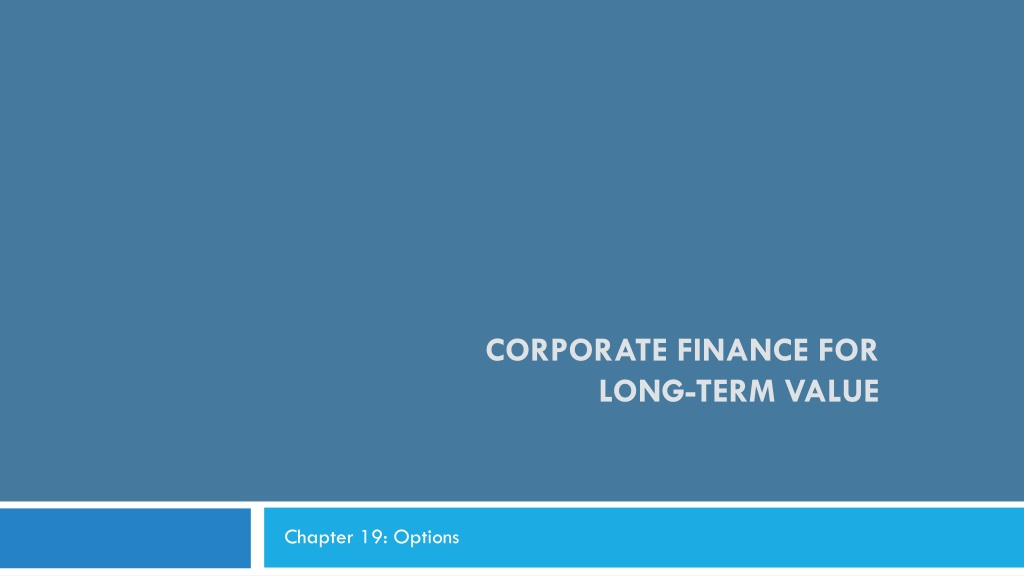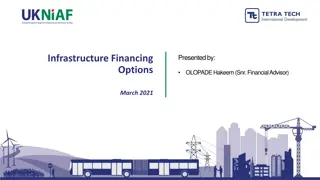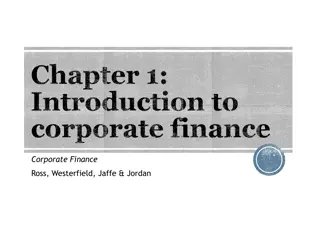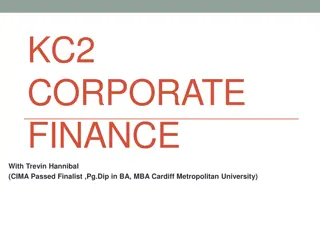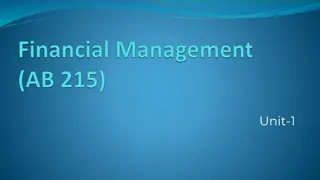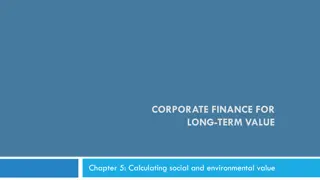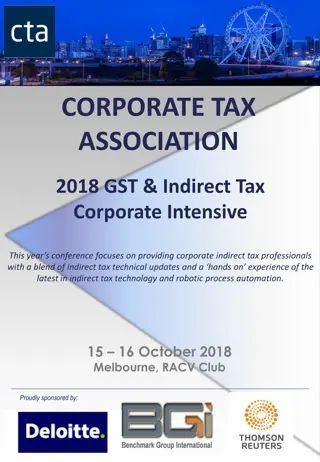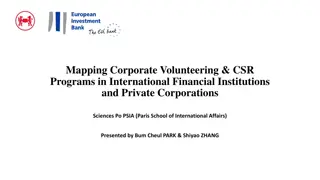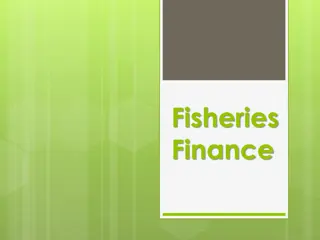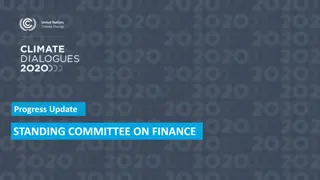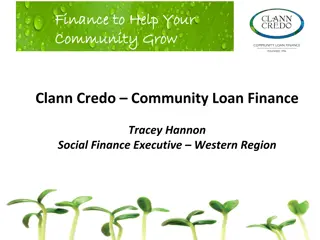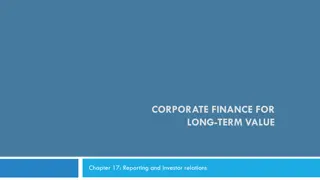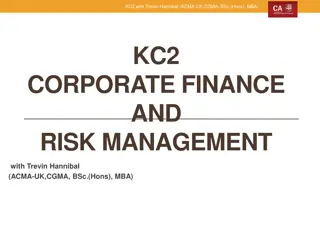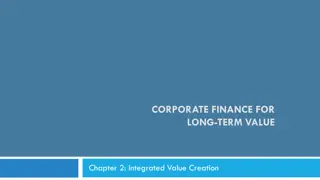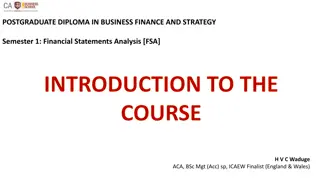Understanding Financial Options: An Overview of Call Options in Corporate Finance
Financial options, specifically call options, provide owners the right to buy securities at specified prices. They offer flexibility to deal with uncertainty and can be valuable tools in corporate financial decision-making. This summary dives into the concept of call options using the example of wheat bushels, explaining payoff structures, premiums, and probabilities associated with different strike prices.
Download Presentation

Please find below an Image/Link to download the presentation.
The content on the website is provided AS IS for your information and personal use only. It may not be sold, licensed, or shared on other websites without obtaining consent from the author. Download presentation by click this link. If you encounter any issues during the download, it is possible that the publisher has removed the file from their server.
E N D
Presentation Transcript
CORPORATE FINANCE FOR LONG-TERM VALUE Chapter 19: Options
Part 5: Corporate financial policies Chapter 19: Options
The BIG Picture 3 Options are contracts that give the owner the right to buy or sell a security at a pre-specified price Discussion Financial options can be used to deal with uncertainty (e.g. declining price) A real option is the opportunity to make a particular business decision, exemplifying the value of flexibility Real options on F can have E or S drivers: payoff in terms of F, but with E or S as the underlying values Companies have a lot of put options against society, but awareness of them is low: this calls for integrated value expressed in real options
Financial options 4 Financial options are option contracts that give their owners the right to sell or buy a security from the writer of the contract at a specified price exercise / strike price The two parties to the contract have opposite positions: The buyer (owner) is long the option and has a right (not obligation) to buy or sell The seller (writer) is short the option and has the obligation to fulfil the contract The owner pays a price for the option to the seller, known as the option premium Two types of options: Call options, which gives the owner the right to buy a security Security can be: company stock, exchange rate, interest rate, commodity, etc. Put options, which gives the owner the right to sell a security
Call option long 5 Consider the example of a call option on a bushel of wheat, with an exercise price of $10 The underlying value is the price of the bushel of wheat The payoff is $0 for every price < $10 12 10 For every price > $10, the payoff is: 8 Pay-off Payoff at > $10 price exercise price 6 4 The formula for a long position in a call is: 2 Payoff at < $10 ? = max(? ?,0) 0 0 1 2 3 4 5 6 7 8 9 1011121314151617181920 Underlying value: price of a bushel of wheat Where ? is the underlying value and ? the exercise price
Call option long (with premium) 6 The longer the maturity of the call, the higher the probability that the underlying value will at some time exceed the strike price and the higher its value Since it has value, investors will be willing 12 10 to pay a price for it, called a premium 8 Payoff at > $10 Suppose the premium for a bushel of wheat 6 Profit is $0.40, then the payoff structure becomes 4 Break-even point: $10.40 Payoff at < $10 2 Note that premiums are not fixed: they move 0 0 1 2 3 4 5 6 7 8 9 10 11 12 13 14 15 16 17 18 19 20 with the price of the underlying security -2 Underlying value: wheat price The buyer pays the premium to the seller at the time both parties enter into the contract, at which time the premium payment is fixed
Call option short 7 The seller, who writes the call, has the exact opposite payoff profile to the buyer The payoff is $0 for every price < $10 Payoff at < $10 2 For every price > $10, the payoff is: 0 0 1 2 3 4 5 6 7 8 9 10 11 12 13 14 15 16 17 18 19 20 -2 - (price exercise price) Pay-off -4 -6 The formula for a short position in a call is: -8 Payoff at > $10 -10 -12 ? = max(? ?,0) Underlying value: wheat price 2 Including $0.40 premium Where ? is the underlying value and ? the exercise price 0 0 1 2 3 4 5 6 7 8 9 10 11 12 13 14 15 16 17 18 19 20 -2 -4 Profit -6 -8 -10 -12 Underlying value: wheat price
Put option long 8 A put option gives the owner the right to sell a security For every price < $10, the payoff is: 12 exercise price price 10 8 The payoff is $0 for every price > $10 Payoff at < $10 Pay-off 6 The formula for a short position in a call is: 4 Payoff at > $10 2 ? = max(? ?,0) 0 0 1 2 3 4 5 9 10 11 12 13 14 15 16 17 18 19 20 Underlying value: wheat price 6 7 8 Where ? is the underlying value and ? the exercise price
Put option short 9 The seller, who writes the put, has the exact opposite payoff profile versus that of the buyer Payoff at > $10 2 For every price < $10, the payoff is: 0 0 1 2 3 4 5 6 7 8 9 10 11 12 13 14 15 16 17 18 19 20 - (exercise price price) -2 -4 Pay-off The payoff is $0 for every price > $10 -6 Payoff at < $10 The formula for a short position in a call is: -8 -10 ? = max(? ?,0) -12 Underlying value: wheat price Where ? is the underlying value and ? the exercise price
Combinations of options & hedging 10 In practice people can have composite exposures: they may use options to hedge their exposures Example: a farmer has a profit which depends on the wheat price Costs are $5 per bushel, so profit is: wheat price - $5 (left graph) By buying the put option with exercise price $10, the farmer gets protection against losses (middle graph) The farmer s payoff: profit before hedging (S - $5) plus the put s payoff (max[K-S,0]) minus the put s premium: (S - $5) + max(K-S,0) - $0.40 at all prices below $10, profit is locked in at $4.60 farmer buys protection at a cost of $0.40 Farmer profit before hedging Put option (including premium) Farmer profit after hedging 20 20 20 15 15 15 10 10 10 Pay-off Pay-off Pay-off 5 5 5 0 0 0 0 2 4 6 8 10 12 14 16 18 20 0 2 4 6 8 10 12 14 16 18 20 0 2 4 6 8 10 12 14 16 18 20 -5 -5 -5 -10 -10 -10 Underlying value: wheat price Underlying value: wheat price Underlying value: wheat price
Combinations of options & hedging 11 A producer of packaged food faces an (almost) opposite exposure The price per bushel hurts its profits since the food company needs to buy wheat for its production Profit per bushel: $17 price per bushel (left graph) By buying a call option with exercise price $10, the food company gets protection against losses (middle graph) The food company s payoff: profit before hedging ($17 - S) plus the call s payoff (max[S-10,0]) minus the put s premium: ($17 - S) + max(S-10,0) - $0.40 at all prices above $10, profit is locked in at $6.60 company buys protection at a cost of $0.40 Food co profit before hedging Call option (including premium) Food co profit after hedging 20 20 20 15 15 15 10 10 10 Pay-off Pay-off Pay-off 5 5 5 0 0 0 2 4 6 8 10 12 14 16 18 20 0 2 4 6 8 10 12 14 16 18 20 0 -5 -5 0 2 4 6 8 10 12 14 16 18 20 Underlying value: wheat price -5 -10 -10 Underlying value: wheat price Underlying value: wheat price
Put-call parity 12 The exposure of the farmer looks like the call option of the 20 producer, but at a higher level (including a bond) 15 10 Pay-off 5 The exposure of the producer looks like the put option of 0 0 2 4 6 8 10 12 14 16 18 20 -5 the farmer, but at a higher level (including underlying) -10 Underlying value: wheat price From this, the assumption follows: 20 ? + ? = ? + ? 15 10 Pay-off The combined payoffs of the underlying value ? and the 5 0 0 2 4 6 8 10 12 14 16 18 20 put ? are equal to the combined payoffs of a bond ? and a -5 -10 Underlying value: wheat price call ? next slide shows put-call parity
Put-call parity expressed in payoff structures 13 S (stock) P (put) 20 20 10 10 Pay-off Pay-off 0 0 S+P=B+C 0 2 4 6 8 10 12 14 16 18 20 0 2 4 6 8 10 12 14 16 18 20 20 -10 -10 10 -20 -20 Underlying value Underlying value Pay-off 0 0 2 4 6 8 10 12 14 16 18 20 B (bond) C (call) 20 20 -10 10 10 -20 Underlying value Pay-off Pay-off 0 0 0 2 4 6 8 10 12 14 16 18 20 0 2 4 6 8 10 12 14 16 18 20 -10 -10 -20 -20 Underlying value Underlying value
Capital structure expressed in options 14 One can view capital structure in terms of options: NPV of projects 20 Debt 5 Equity can be seen as a call option on the company s assets Equity 15 Corporate debt is effectively riskless debt minus a put on the company s assets Total assets 20 Total liabilities 20 The NPV of projects is the driver of the value of assets and the value of equity Call value of equity 35 If the NPV of projects falls below 5, equity value goes to 0 30 Value of equity at the current value of the company (20) and a strike price (value of debt) of 5 Pay-off to equity 25 For all values above 5, the value of equity 20 moves proportionately with the NPV of projects 15 10 5 ?????? ?? ? ???? = ? = max(?????? ????,0) 0 0 2 4 6 8 10 12 14 16 18 20 22 24 26 28 30 32 34 Underlying value: company value
Corporate debt in terms of options 15 Since equity can be expressed in options, it follows from put-call parity that corporate debt can also be expressed in terms of options ? + ? = ? + ? Where ? = assets, ? = put on assets, ? = riskless debt and ? = call on assets As such: assets = ? = ? ? + ? Assets are financed by risky debt and equity, and since equity = ?, it follows: ????? ???? = ?????? ?????? = ? ? + ? ? = ? ? Risky debt = riskless debt put on assets
Corporate debt in terms of options 16 Value of risky debt is 5 at the current value of the company (20) and a strike price of the put of 5 Below a company value of 5, the written put has a negative payoff
Option quotations 17 Options are most commonly traded on stocks Example of 3M stock with 3 strike prices Strike price is the fixed price at which the owner of the option can by or sell the underlying security Strike* C or P Bid* Ask* Open interest Bid price is the price at which the market-makers are willing to buy the option C 53.50 55.55 0 60 P 2.97 3.90 20 Ask price is the price at which the market-makers are willing to sell the option C 20.50 21.75 17 110 P 16.90 18.00 64 Open interest refers to the number of option contracts that are held by traders in active positions C 5.65 6.45 25 160 P 49.15 50.70 2 * Per October 2022, with expiration in January 2025
Option quotations 18 As of October 2022, 3M stock was $113.45 At $60, the call option is very much in-the-money , whereas the put option is out-of-the-money Strike* C or P Bid* Ask* Open interest The difference between the stock price and exercise price is the intrinsic value of the option C 53.50 55.55 0 60 For $60 call option: $113.45 - $60 = $53.45 P 2.97 3.90 20 C 20.50 21.75 17 For $60 put option: $60 - $113.45 = 0 110 P 16.90 18.00 64 The average of the bid and ask is the option value C 5.65 6.45 25 160 The option value minus the intrinsic value is called the time P 49.15 50.70 2 value of the option * Per October 2022, with expiration in January 2025 For $60 call: ($55.55 + $53.50) / 2 = $54.53 - $53.45 = $1.08 ?????? ????? = ????????? ????? + ???? ????? For $60 put option: ($3.90 - $2.97) / 2 = $3.44 - $0 = $3.44 (see next slide)
Option value = intrinsic value + time value 19 6 Value 5 4 option value (red line) 3 2 intrinsic value (blue line) 1 strike price, K time value 0 0 1 2 3 4 5 6 7 8 9 10 Stock price
Valuing options 20 The non-linear nature of option payoffs makes valuation of options difficult The binomial option pricing model prices options by making the simplistic assumption that at the end of the next period (??= 3%), the underlying value has only two possible values The two-state single period model values a call option by building a replicating portfolio, which is a portfolio of other securities with the same value as the option in one period Stock: ??= $12 Bond: ? 1 + ?? = $1.03 Call: ??= max($12-$10,$0) = $2 up Stock: S = $10 Bond: B = $1 down Stock: ??= $8 Bond: ? 1 + ?? = $1.03 Call: ??= max($8-$10,$0) = $0
Binomial model step 1 21 The idea is to buy stock in such proportions that they give the same payoffs as the call The first step is to determine the option delta (or hedge ratio), which is the number of stocks needed to replicate or hedge the call: =spread of possible option prices spread of possible stock prices=?? ?? $? $? $?? $?= 0.5 ?? ??= Stock: ??= $12 Bond: ? 1 + ?? = $1.03 Call: ??= max($12-$10,$0) = $2 up Stock: S = $10 Bond: B = $1 down Stock: ??= $8 Bond: ? 1 + ?? = $1.03 Call: ??= max($8-$10,$0) = $0
Binomial model step 2 22 The second step is to determine the number of bonds needed to finance the stock position The replication, for one time period later, is: To derive the number of bonds: ? = ?? ?? For the up-state: ??= ?? 1 + ?? ? 1+?? Up-state: ? =0.5 $?? $? = $3.88 For the down-state: ??= ?? 1 + ?? ? 1.03 Down-state: ? =0.5 $? $? = $3.88 1.03 Stock: ??= $12 Bond: ? 1 + ?? = $1.03 Call: ??= max($12-$10,$0) = $2 up Stock: S = $10 Bond: B = $1 down Stock: ??= $8 Bond: ? 1 + ?? = $1.03 Call: ??= max($8-$10,$0) = $0
Binomial model step 3 23 The final step is to determine the price of the call The price of the call option in the binomial model is as follows: Value of call = [delta x stock price] - [bonds] ? = ? ? ? = 0.5 $10 $3.88 = $1.12 Stock: ??= $12 Bond: ? 1 + ?? = $1.03 Call: ??= max($12-$10,$0) = $2 up Stock: S = $10 Bond: B = $1 down Stock: ??= $8 Bond: ? 1 + ?? = $1.03 Call: ??= max($8-$10,$0) = $0
Binomial model step 4 (overview) 24 Period t = 0 Period t = 1 Instrument Up Down ? ? = 0.5*$10 - $3.8835 = $1.1165 ?? 1 + ?? ? = 0.5 * $12 (1.03) * $3.8835 = $6 - $4 = $2 ?? 1 + ?? ? = 0.5 * $8 (1.03) * $3.8835 = $4 - $4 = $0 Replicating portfolio Call ? = $1.12 ? = $2 ? = $0 Stock: ??= $12 Bond: ? 1 + ?? = $1.03 Call: ??= max($12-$10,$0) = $2 up Stock: S = $10 Bond: B = $1 down Stock: ??= $8 Bond: ? 1 + ?? = $1.03 Call: ??= max($8-$10,$0) = $0
Put option in binomial model 25 The calculation of the put price occurs in a similar way to the call price Option delta =spread of possible option prices spread of possible stock prices=?? ?? $0 $2 $12 $8= 0.5 = ?? ?? Number of bonds ? = ??+?? = 0.5 $12+$0 1.03 = $5.83 1+?? Value of put = [delta x stock price] + [bonds] = ? = ? + ? = 0.5 $10 + $5.83 = $0.83 Stock: ??= $12 Bond: ? 1 + ?? = $1.03 Call: ??= max($10-$12,$0) = $0 up Stock: S = $10 Bond: B = $1 down Stock: ??= $8 Bond: ? 1 + ?? = $1.03 Call: ??= max($10-$8,$0) = $2
Multiperiod binomial model 26 The formula for the option delta can be interpreted as the sensitivity of the option s value to changes in the stock price at each point in time We can value the call option in the multiperiod binomial tree by working backwards from t = 2 Option deltas t = 0 t = 1 t = 2 $14 up =?? ?? ?? ?? $4 $0 $14 $10= 1 = $12 up down S = $10 $10 up =?? ?? ?? ?? $0 $0 $10 $6= 0 down $8 = down $6 A call with zero payoffs in the future, also has zero value today
Multiperiod binomial model 27 ? = ?? ?? =1 $14 $4 1.03 = $9.709 1+?? ? = ? ? = 1 $12 $9.709 = $2.291 Value of call option in the up-state at t = 1 t = 0 t = 1 t = 2 $14 up $12 up down S = $10 $10 up down $8 down $6
Multiperiod binomial model 28 =?? ?? ?? ??=$2.291 $0 = 0.573 $12 $8 Value of call option at t = 0, Slightly higher than the one-period call with a value of $1.12 ? = ?? ?? =0.573 $12 $2.291 1.03 = $4.449 1+?? ? = ? ? = 0.573 $10 $4.449 = $1.279 t = 0 t = 1 Stock: ??= $12 Call: ??= $2.291 up S = $10 Stock: ??= $8 Call: ??= $0 down
Option pricing models 29 1. From binomial option pricing model for two periods 2. To multiperiod binomial option pricing model for multiple periods Refine the tree by cutting the maturity of call option in ever smaller periods Ending up in a continuous returns distribution 0.45 0.40 0.35 3. To Black-Scholes option pricing model 0.30 0.25 Probability 0.20 Based on normal distribution of returns 0.15 0.10 0.05 0.00
Black-Scholes option pricing model 30 The Black-Scholes formula for the price of a call on a non-dividend paying stock follows the set-up of the binominal model: Value of call = [delta x stock price] [bonds] ? = ? ?1 ? ?(?2) ?? ? Where: ? is the current price of the underlying stock ??(?) is the present value of a risk-free zero-coupon bond that pays ? ? is the exercise price ?(?) is the cumulative normal probability distribution ?1=ln[ ? ? 2 ?2= ?1 ? ? ? is annual volatility of the stock s returns ? refers to the number of years until expiration 0.45 0.40 0.35 ? ?? ? ] +? ? 0.30 0.25 Probability 0.20 0.15 N(d) 0.10 0.05 0.00 0 d
European dividend paying stocks 31 The Black-Scholes formulas are derived for non-dividend paying stocks They can easily be adjusted for dividend paying stocks The European call option holder has no rights to any dividends paid out prior to expiration European options can only be exercised at the expiration date American options allow the owner to exercise the option at any time For European call options, we can deduct the present value of missed dividends ??(???) from the stock price ?: ? = ? ??(???)
Implied volatility & risk of options 32 While most parameters are easy to calculate, volatility of stock price is more difficult to calculate The most direct way is to calculate a stock s volatility from historical stock prices Traders sometimes take a shortcut by deriving a stock s volatility from current market prices of traded options Estimating a stock s volatility that is implied by an option s market price is called implied volatility We can derive the risk of an option from the underlying replicating portfolio The beta of the option ???????is a weighted average of the beta of the stock and the bond ? ? ???????= ? + ? ??????+ ? + ? ????? ? ?+? ?????? Given that the bond is risk-less, ?????= 0 ???????= While the beta of a call is positive, the beta of a put is typically negative reflecting the short position in stocks
Drivers of option prices 33 The Black-Scholes formulas reveal the drivers of option prices Drivers have different signs for calls and puts (see table) Strike price Risk-free interest rate Driver Call option Put option Underlying value + - Underlying value + + Volatility - + Strike price Option price Time to expire Volatility + + Time to expiration + - Risk-free interest rate
Real options 34 A real option is the opportunity to make a particular business decision gives flexibility In contrast to financial options: They are not exchange traded There is no formal option contract There is no clear counterparty Similar to financial options, real options have a payoff that depends on factors such as the underlying value and a strike price on that underlying value Being long in real options provides valuable flexibility to exercise an opportunity Being short in real options can be very risky and value destructive You typically cannot price real options by no-arbitrage principles since these real options are not redundant This means you cannot make a replicating portfolio to price real options
Application of real options 35 Many corporate assets, particularly growth opportunities, can be viewed as call options (Myers, 1977) Such real options depends on discretionary future investment by the firm Example: a company has developed an innovative technology The company now has a put option on the production costs of the innovative technology The strike price is the production cost of the traditional technology When costs of the innovative technology go down, the put option comes in-the-money Luehrman (1998): In financial terms, a business strategy is much more like a series of options than a series of static cash flows
Types of real options 36 Koller, Goedhart and Wessels (2020) provide a classification of real options: Option to defer (a call): flexibility to wait and do the same action later Abandonment option (put): option to stop an operation Follow-on (compound) option: a series of options on options Option to expand (call) or contract (put): flexibility in the size of the operations Option to extend (call) or shorten (put): flexibility to adapt the lifetime of an operation Option to increase scope (call): flexibility to add other operations Switching options: flexibility to choose between different operations
Drivers of real options 37 Drivers of real options follow from the drivers of financial options Key point: uncertainty - measured as volatility of cash flows - enhances the flexibility value Cash flows existing business Investment costs Lost cash flows Underlying cash flows alternative Risk-free interest rate Enhances flexibility value Uncertainty (volatility) about CF Time to expire Source: Adapted from Koller, Goodhart and Wessels (2020)
Decision tree analysis for real options 38 Real options can be analysed using decision trees, which are a graphical representation of future decisions under uncertainty Example: investing in a mine t = 0 t = 1 t = 2 The investment at t = 0 effectively $5500 million Metal prices rise (50% chance) buys the company an exposure to metal prices Once the mine has been built at t = 0, Invest in a mine -$2500 million the investment in the mine is not a $800 million Metal prices fall (50% chance) call anymore at t = 1 The call lies before that at t = 0: the choice to build the mine or not Don t invest in a mine $0
Decision tree analysis for real options 39 t = 0 t = 1 t = 2 $5500 million Metal prices rise (50% chance) Invest in a mine -$2500 million $800 million Metal prices fall (50% chance) Conclusion: the expected payoff is positive, so the company should invest in the mine Don t invest in a mine $0 Total expected payoff (6) (5)*(2) 1,500 -850 650 Expected payoff (3) Previous payoff (4) Total payoff (5) Scenario Payoff (1) Probability (2) (1)*(2) 2,750 400 3,150 (1)+(4) 3,000 -1,700 Calculation Metal prices rise Metal prices fall Total 5,500 800 50% 50% 100% -2,500 -2,500
Corporate use of real options 40 In corporate practice, the use of real options is not as widespread as academics had imagined Managers tend to favour DCF analysis in capex decisions, or simpler but flawed alternatives, such as the payback criterion Triantis and Borison (2001) identify three main corporate uses of real options: As a strategic way of thinking As an analytical valuation tool As an organisation-wide process for evaluating, monitoring, and managing capital investments Often, managers are not aware of the options they have, since these options are not explicitly presented as such ( opaque framing ) and are thus not identified in the first place
Real call positions driven by E and S 41 How to think about real call options driven by E and S? On the long side, calls result from grasping E and S opportunities On the short side are incumbent companies that are currently destroying value on E or S The intrinsic value of the long call increases with the size of the positive externality (opportunity) The value of the short call decreases with the size of the negative externality (incumbent technology) The intrinsic value of the real call option increases with the attractiveness of the new technology and decreases with the attractiveness of the incumbent technology As the new technology becomes competitive, the value of the long call goes up and might come in- the-money, while that of the short call falls
E and S drivers of real call options on F 42 Long call Short call Size of the positive externality of the new technology relative to the old technology + - Underlying value + - + - + - CFs new technology CFs incumbent technology Strike price Transition tensions Volatility Economic life of the incumbent technology + - Time to expiration PV of the incumbent technology (strike price) Risk-free interest rate + -
Example of DSMs product Bovaer 43 DSM has developed the product Bovaer, which reduces methane emissions of cows The development cost of Bovaer is the option premium at 4 per unit product The strike price of the call is the production cost of Bovaer at 5 per unit product Note: these numbers are fictional and intended for illustrative purposes 8 DSM will start producing and selling Bovaer (i.e. exercising the call option) as soon as the methane tax exceeds the strike price Profit 6 4 2 0 1 2 3 4 5 6 7 8 9 10 11 12 13 14 15 Methane tax -2 DSM will break even at a methane tax of 9 -4 -6 From a short call perspective: as the transition tensions and/or size of externality increases (i.e. the methane tax rises), the risk of doing nothing increases This should push companies to consider strategies that avoid this risk by phasing out old technologies
Real put positions driven by E and S 44 Practical example of a short put: Boeing taking short-curs in safety Every year Boeing benefits from cost reductions (put premium) Until one year this led to an accident and massive costs The underlying value is the safety level of the aircraft: the probability that no accidents happen which will result in large fines Long put Short put Safety level as measured by: - Health of passengers - Avoiding multi-billion dollar fines Passengers arrive safely due to safety investment Swings in resulting safety levels Safe transport and arrival of - - + + Underlying value passengers is the threshold and + - Strike price strike price: below that price, + + - - Volatility Use time of the planes produced Time to expiration costs rise significantly - + PV of the safety investment Risk-free interest rate
Comparing call and put examples 45 There are at least three differences between the put and call examples The put examples are not a transition risk: it is not a bigger societal challenge, but purely the result of decisions to economise on safety The short puts are not driven directly by competing products: there is no new technology that can eradicate the negative externality There is no clear counterparty that has the exact mirror position There are also similarities: Both long calls and short puts have a competitive element: Companies that invest in long calls increase their competitive composition by frontloading new technology Companies that write short puts increase their competitive position by cutting costs
Integrated value as a set of real options 46 Companies can create options for specific stakeholders (i.e. shareholders, employees) at the expense of other stakeholders The integrated value perspective helps to make such situations visible, by explicitly comparing EV, FV and SV S assets 20 S debt 5 S equity 15 We can express the market value balance sheet as E assets 15 E debt 25 E equity -10 a combination of risk-free assets and liabilities and F assets 25 F debt F equity 5 options on F, S, and E 20 Total integrated assets Total integrated liabilities 60 60 ?????? = ????? ???? + ?????? = ? ? + ? ?? = (? ???? + ? ???? ? ???) + (? ???? + ? ???? ? ???) + (? ???? + ? ???? ? ???) see next slide
IV balance sheet 47 EV = E bond + call on E - put on E + : natural capital improvements realised - : natural capital destruction caused biodiversity damage resulting from activities example: still to be realised emission savings + FV = F bond + call on F - put on F potential additional CF from current / new projects / products potential reductions in CF from current / new projects / products example: CF from business as usual + SV = S bond + call on S - put on S still to be experienced health reductions from, for example, savings on safety + : health improvements realised - : health reductions caused still to be realised health improvements example: = IV = I bond + call on I - put on I
Conclusions 48 Financial options are contracts that give the owner the right to buy or sell a security at a pre-specified price The seller or writer, who is short the option, has the opposite position of the buyer, and has to exercise the contract if the buyer wants to do so A real option is the opportunity to make a particular business decision, exemplifying the value of flexibility One can visualise both financial options and real options with decision trees and payoff graphs Real options on F can have E or S drivers: payoff in terms of F, but with E or S as the underlying values Companies have a lot of put options against society, but awareness of it is low: this calls for an integrated view on options or integrated value expressed in real options
